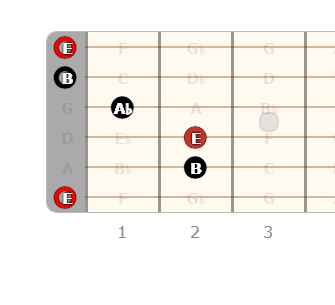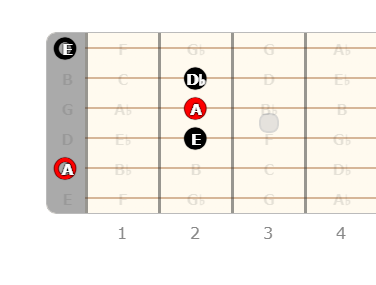How to learn music theory for guitar II
We continue with our exploration of music theory for guitar.
LEARNING GUITAR
4 min read
We will continue to build on the function of scales. For this article we will stay with the E major scale to model from, that seems to be more relevant to the guitar.
The E major scale, as with all Major Scales, have a pattern that is translated in Steps, or tones. These are the musical distances between notes, for this article this distance will be referred to as steps. On guitar a step can be considered the movement up or down the neck by 2 frets. A half step will be the movement of one fret. Study the diagram below of the E major notes on the bass E string.


Looking at the fretboard diagram we see that Ab(flat)-A are a half step apart, and the same pertains to Eb(flat)-E. From the diagram we can also see that the pattern of steps is, Whole Step-Whole Step-Half Step-Whole Step-Whole Step-Whole Step-Half Step, or condensed W-W-H-W-W-W-H. This formula functions with all major scales. Start with a root note of F and play the pattern of the major scale and you just produced the F major. Knowing this we can build any major scale, and play them on the fret board.
The major scale can also be used to build Chords. Study the diagram of the E chord below.


The root E in red is the center note of this chord, and the other notes are all taken from the E major scale to build the E chord. Study where the notes that make the E chord fall in the scale, the note positions are the scale degrees. E is the first note 1, G#/Ab is the 3rd note and B is the 5th note from the E major scale, to complete the Triad, or trio of notes that build the chord, we use the 1st, 3rd, and 5th degrees.
Knowing this we can build major chords from any major scale using the formula of 1st 3rd and 5th degrees of the major scale. The diagram of the A major below will illustrate how we build A major using the 1st, 3rd, and 5th degrees of the A major scale.


To build A major we use the 1st, 3rd, and 5th degrees, A, Db(Flat),and E.
Each scale degree not only helps with building chords, it also helps with identifying modes with in the major scale. Modes are often thought of as separate scales, this could be considered correct, but they are actually part of the major scale. Modes can be used for building chords, and identifying keys of music. Modes can be used to change the mood of a melody, by making it seem darker, or brighter. So what are modes?
Modes are the identified by their root as to where they fall in the Major scale. The major scale itself is a Mode and falls in the 1st degree. This mode is know as the Ionian mode, the pattern of the Ionian mode is the pattern of the major scale. W-W-H-W-W-W-H. So, from E major we identify the first degree mode as E Ionian.
As we continue to identify the modes in the major scale, it is worth noting that the pattern or formula changes with each mode. Which is why often times modes are thought of separate scales. The modes of the Major scale are listed below along with the pattern. We are still using E major as the example, but the theory applies to all the Major scales.
1st Degree E Ionian-WWHWWWH
2nd Degree F# Dorian-WHWWWHW
3rd Degree G# Phrygian-HWWWHWW
4th Degree A Lydian-WWWHWWH
5th Degree B Mixolydian-WWHWWHW
6th Degree C# Aoelian-WHWWHWW
7th Degree D# Locrian-HWWHWWW
So what is happening here with the modes? Take notice of the step and half step pattern of each mode. The 1st mode Ionian has the pattern of WWHWWWH, if we take the first step and move it to back of the line, we create the pattern for the 2nd mode of the Major scale Dorian. To make the 3rd mode Phrygian we move the first step of the Dorian mode to back of the line and we have the Phrygian pattern.
So from this we learn that moving in modes of the major scale means that we have to move the steps of the previous scale to the back of the Major Scale pattern. The Locrian mode is 6 degrees from the Ionian mode. So, in order to create the Locrian mode we need to move the first 6 steps to the back of the major scale pattern. Knowing this we can count how far we are from the 1st degree of the major scale and move that number of steps to the back of the Major scale and we create a mode within the Major scale.
For learning it would be very overwhelming to learn all the modes for the Major scales, learning the step pattern however is much less of a task. Knowing the step and half step pattern of a scale allows us to start anywhere on the fret board. If we want to learn the Major scale in F. We start the pattern on F and move the steps and half steps to create the Major pattern. From here we can figure out the modes using the same theory. It all comes down to how we use whole steps and half steps.
Modes can get very confusing when thought of as different scales. They are actually just a part of the major scale, with parts of the step pattern moved to the back. Learning the step patterns will be more useful and will take less time than learning all the modes and scales by note. With the step patterns we can start anywhere on the fret board and create a mode. Over time identifying the notes on the fret board will be easier as you experiment with starting scales from different root notes.
As you learn more songs, the theory starts to make sense. You begin to identify chord progressions, and scale patterns within solos. When starting out with guitar, first learn songs, and don't focus so much on trying to commit scales and modes to memory. Learn the patterns. Now grab your guitar and play.
For more guitar related content and gear reviews please visit Garage Shop Guitarist.
